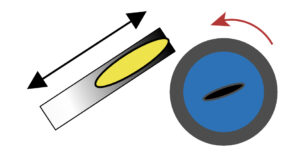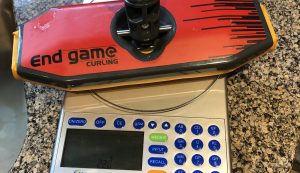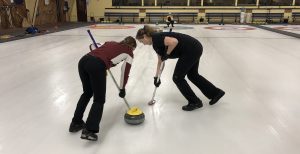Brushing

Pressure distribution in selected curling brush heads
This research is joint work with Dr. John Newhook, Dr. Michel Ladouceur, and Dr. Ryan Frayne of Dalhousie University in Halifax. John is a Professor of Civil Engineering and the Dean of Engineering at Dalhousie, while Michel and Ryan are assistant professors in the Kinesiology department of the School of Health and Human Performance at Dalhousie. At the 2022 North American Conference on Biomechanics (NACOB) held the week of August 22-25 in Ottawa, we presented our initial work that compared a variety of commercial brush heads in how they distributed pressure across their pads in a static laboratory setup. Forces and pressures were recorded using two 3200E Tekscan (Tekscan Inc., Boston, MA) pressure sensors affixed to the top of an AMTI BP400600 force plate (AMTI Inc., Watertown MA), with the sensel areas abutted. CONFORMat Research software (version 7.1: Tekscan Inc.) was used to collect the pressure sensor data, which was recorded at a frequency of 100 Hz. Our results are

Does brushing with a brush turned to 90 degrees really work?
Recently I’ve received numerous inquiries regarding teams rotating their brush heads 90 degrees when attempting to “carve” a stone (accentuate curl). Some tour players, as well as commentators, have adopted the term “knifing” for this tactic. As of the date of this post – 26 March 2022 – I’ve probably been asked the question at least twenty times and so, rather than continue to respond individually to each questioner, I decided to post this short article. As usual, this post is joint work with my research colleague John Newhook of Dalhousie University in Halifax. Short answer The question isn’t, really, whether or not using a brush head turned 90 degrees “works”. Applying brushing forces – and hence thermal energy – to the ice on one side of a stone over the other is going to have an effect on a stone’s trajectory. The actual question to be answered is under what conditions is brushing using a brush head turned 90

Zeroing a PT-2 Smartbroom
Even though the PT-2 has been discontinued by Canadian Curling Tools in favour of their new “Smartbroom” device, a number of curling associations and individual coaches continue to use PT-2 instrumented brushes with their teams. A characteristic of the PT-2 that coaches must be aware of is the frequent need to “zero” the PT-2 brush to ensure that the force readings from the brush are as accurate as possible. The need for this is because the PT-2’s load sensors are cemented into the brush’s EQ brush pad, and over-tightening of the bolts that fix the brush pad in place can result in skewed measurements. As I’ve been asked a few times about the zeroing method for the PT-2 I decided to post this article. PT-2 documentation is no longer available on the Canadian Curling Tools website. To zero a PT-2 brush, follow these steps: Ensure that the brush head is plugged into the PT-2’s display unit, and the unit is

Brush head mass – a short survey
During my talk at the online Adapting/Thriving 2021 Conference presented by the Ontario Curling Council, and other provincial sport organizations, I made several statements regarding potential parameters to the selection of a brush, among them being the size of the brush pad and its contact area with the ice. Even though WCF-approved brush heads and pads all utilize the same Oxford 55 420D yellow nylon fabric, and are tested by the National Research Council for compliance with World Curling Federation specifications, there are differences amongst the available products. Some brush pads have an integrated design, comprising the base, foam, and fabric as a single unit, whereas other brush pad designs use separate components so that the Oxford 55 fabric can be replaced independently of the foam or base. Perhaps the most interesting brush to do this is the End Game brush from Madison, Wisconsin, where the replacement fabric comes simply in die-cut sheets of Oxford 55 nylon. With the End

How far can one carry a stone via brushing?
After questions regarding directional brushing, perhaps the second-most often asked question I receive is the question of how much distance brushing can add to the trajectory of a stone. While it is tempting to consider a cut-and-dried response, the issues involved in brushing are both complex and incompletely understood, since we are still researching the physics behind what makes a curling stone “curl” in the first place. Experienced players know that under some conditions it seems that brushing can carry a stone a significant additional distance, yet at other times it doesn’t seem to matter how hard one brushes, the impact upon the stone’s travel is minimal. Answering the question of brushing impact involves an analysis of three significant variables: the characteristics of the ice surface, and the corresponding environment within the arena; the characteristics of the curling stones themselves, and how they were thrown; and the abilities and techniques of the player(s) involved in brushing. Let’s look at these

Summer training plans for front-end players
As I write this, I am a mere four weeks from returning to the ice at the Curling Canada NextGen camp, to be held at the K-W Granite Club here in Waterloo. The OJCT Tour will begin Labour Day weekend – just six weeks away. With the competitive U21 season in Ontario so compressed – 12 weeks between Labour Day and U-21 qualifiers – the summer months are THE time to improve one’s fitness, enhance flexibility, and permit injuries to heal. Between the demands of post-secondary school and the competitive season, there will be little time to improve one’s fitness during the fall semester. Rather, the best one can hope for is to maintain the elevated fitness levels achieved during the summer months through the competitive season. Every competitive player should have a summer training plan designed by a qualified personal trainer or kinesiologist. While a “generic” training plan is slightly less costly, ideally a customized plan designed for you